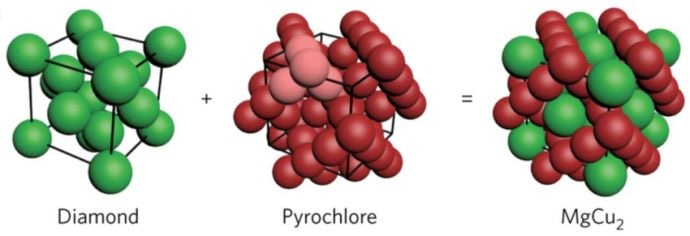Mar 1 2017
 The superlattice is made up of two interpenetrating sublattices, one diamond, shown in green, and the other pyrochlore, shown in red. Preformed red tetrahedral clusters and green spheres self-assemble into a MgCu2 superlattice. Credit: NYU Tandon School of Engineering
The superlattice is made up of two interpenetrating sublattices, one diamond, shown in green, and the other pyrochlore, shown in red. Preformed red tetrahedral clusters and green spheres self-assemble into a MgCu2 superlattice. Credit: NYU Tandon School of Engineering
Colloidal particles that are used in a wide array of technical applications, such as cosmetics, inks, paints, and foods, have the ability to self-assemble into an exceptional range of crystalline structures that are densely packed.
For many years, scientists have been working to coax colloidal spheres so that they self-assemble into more thinly distributed lattices to allow the release of potentially valuable optical characteristics. Such structures are known as photonic crystals and have the ability to miniaturize optical components, enhance the efficiency of lasers, and greatly increase the ability of engineers to control the light flow, by a great degree.
An innovative pathway to enable the self-assembly of the elusive photonic crystal structures - that have never been arranged earlier on the sub-micrometer scale - has been discovered by researchers and engineers at the NYU Tandon School of Engineering Department of Chemical and Biomolecular Engineering, the NYU Center for Soft Matter Research, and Sungkyunkwan University School of Chemical Engineering in the Republic of Korea, where 1 nm is smaller than the diameter of one strand of human hair by nearly 100 times.
The study, presenting an innovative design principle that uses preassembled components for constructing a desired superstructure, similar to a prefabricated house that was constructed from pre-built sections, has been published in the journal Nature Materials. The research team describes that the colloidal spheres could be assembled into pyrochlore and diamond crystal structures, a specifically tough challenge as much of the space is unoccupied.
The research team included Etienne Ducrot, a post-doctoral researcher from the NYU Center for Soft Matter Research; Mingxin He, a doctoral student in chemical and biomolecular engineering at NYU Tandon; Gi-Ra Yi from Sungkyunkwan University; and David J. Pine, chair of the Department of Chemical and Biomolecular Engineering at NYU Tandon and a NYU professor of physics in the NYU College of Arts and Science.
The researchers were motivated by a metal alloy of copper and magnesium that naturally exists in pyrochlore and diamond structures as sub-lattices. The team observed the ability of the complex structures to be decomposed into tetrahedral clusters, or four permanently bound spheres, and single spheres.
In order to achieve the decomposition in lab, the researchers formulated sub-micron plastic colloidal spheres and clusters, and used DNA segments attached to the surface of the colloidal spheres and clusters to initiate the self-assembly with the desired superstructure.
We are able to build those complex structures because we are not starting with single spheres as building blocks, but with pre-assembled parts already ‘glued’ together. We fill the structural voids of the diamond lattice with an interpenetrated structure, the pyrochlore, that happens to be as valuable as the diamond lattice for future photonic applications.
Etienne Ducrot, Post-Doctoral Researcher, NYU
Ducrot added that open colloidal crystals, for example, crystals with pyrochlore and diamond configurations, are sought-after because, if made of the apt material, these crystals include photonic band gaps, referring to arrays of light frequency that lack the ability to travel through the structure, thus indicating that they can conduct light similar to the way in which semiconductors conduct electrons.
This story has been a long time in the making as those material properties have been predicted 26 years ago but until now, there was no practical pathway to build them. To achieve a band gap in the visible part of the electromagnetic spectrum, the particles need to be on the order of 150 nanometers, which is in the colloidal range. In such a material, light should travel with no dissipation along a defect, making possible the construction of chips based on light.
Etienne Ducrot, Post-Doctoral Researcher, NYU
According to Pine, the self-assembly technique is highly important in producing the crystals in an economically practicable way because producing these crystals at bulk amounts using lithography methods at the right scale will be highly expensive and extremely difficult.
“Self-assembly is therefore a very appealing way to inexpensively create crystals with a photonic band gap in bulk quantities,” stated Pine.
The U.S. Army Research Office funded the study under a Multidisciplinary University Research Initiative (MURI) grant.